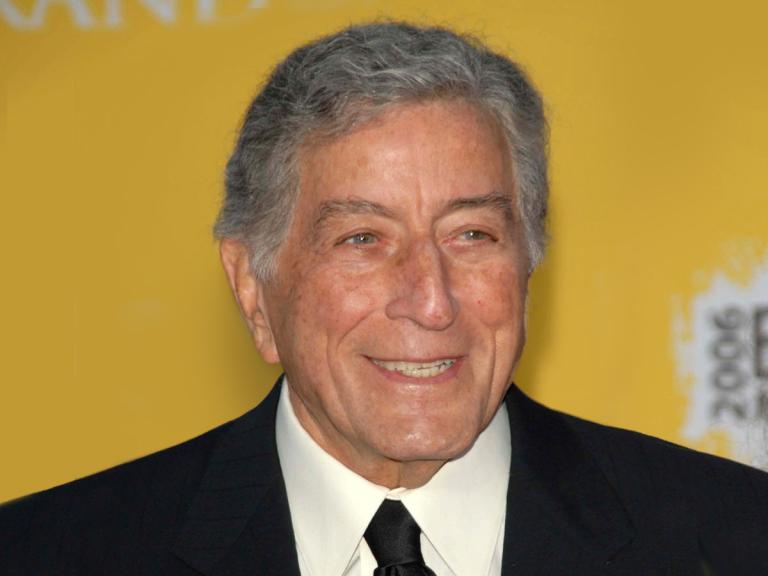
Tony Bennett, the famous and timeless singer whose dedication to classic American songs and knack for creating new standards like “I Left My Heart In San Francisco,” which made a decadeslong career that brought fans from Frank Sinatra to Lady Gaga, passed away at 96, two weeks before he would turn 97.
His publicist, Sylvia Weiner, confirmed his death to The Associated Press, saying he died in his hometown of New York. While there’s no specific cause at this time, Bennett was diagnosed with Alzheimer’s disease in 2016.
Bennett was the last of the great saloon singers of the mid-20th century and often said his ultimate ambition was to create “a hit catalog rather than hit records.” He released over 70 albums, bringing in 19 Grammys and enjoyed lasting and deep affection from fellow artists and fans.
Though he was usually associated with San Francisco, Bennett always noted that his true home was Astoria, a working-class community in the New York City borough of Queens, where he grew up during the Great Depression. He chose his old neighborhood as the site for the “Fame” style public high school, the Frank Sinatra School of The Arts, that he and his third wife, Susan Crow Benedetto, helped found in 2001.
The school isn’t far from the birthplace of the man who was Anthony Dominick Benedetto. His Italian immigrant father inspired his love of singing, but he died when Tony was 10. He credited his mother, Anna, with teaching him a valuable lesson as he saw her working at home, supporting three children as a seamstress doing piecework after his father died. In 1947, Bennett made his first recording for a small label under the stage name Joe Bari.
His big break came in 1949 when Pearl Bailey invited him to join her revue at a Greenwich Village club. Bob Hope stopped by one night and was so impressed that he offered Bennett a spot opening his shows at the famous Paramount Theater, where teens swooned for Sinatra. However, the comedian didn’t like his stage name and believed his real name was too long for the marquee. “He thought for a moment, then he said, ‘We’ll call you Tony Bennett,’” the singer wrote in his autobiography, “The Good Life,” published in 1998.
Bennett’s early career peaked in the 1960s as he topped the charts with “San Francisco” and became the first male pop solo performer to headline at Carnegie Hall, releasing a live album of the 1962 concert. In 1966, he released “The Movie Song Album,” a personal favorite that featured Johnny Mandel’s Oscar-winning song “The Shadow of Your Smile” and “Maybe September,” the theme from “The Oscar,” noteworthy because it marked Bennett’s first and only big-screen acting role.
Bennett was named a Kennedy Center Honoree in 2005 and a National Endowment for the Arts Jazz Master in 2006. He also won two Emmy Awards for “Tony Bennett Live By Request: A Valentine Special” (1996) and “Tony Bennett: An American Classic” (2007).
Bennett endured so long and well that he gained new fans and collaborators, some young enough to be his grandchildren. In 2014, at age 88, Bennett broke his record as the oldest living performer with a No. 1 album on the Billboard 200 chart for “Cheek to Cheek,” his duet project with Lady Gaga.
Three years earlier, he topped the charts with “Duets II,” featuring such contemporary stars as Gaga, Carrie Underwood and Amy Winehouse, in her last studio recording. His rapport with Winehouse was captured in the Oscar-nominated documentary “Amy,” which showed Bennett patiently encouraging the insecure young singer through a “Body and Soul performance.” His final album, the 2021 release “Love for Sale,” featured duets with Lady Gaga on the title track, “Night and Day,” and other Porter songs
Besides singing, Bennett pursued his lifelong passion for painting by taking art lessons and bringing his sketchbook on the road. His pictures, signed with his family name Benedetto, including portraits of his musician friends and Central Park landscapes, were displayed in public and private collections, including the Smithsonian Museum of American Art.
He is survived by his wife Susan, daughters Johanna and Antonia, sons Danny and Dae and nine grandchildren.
